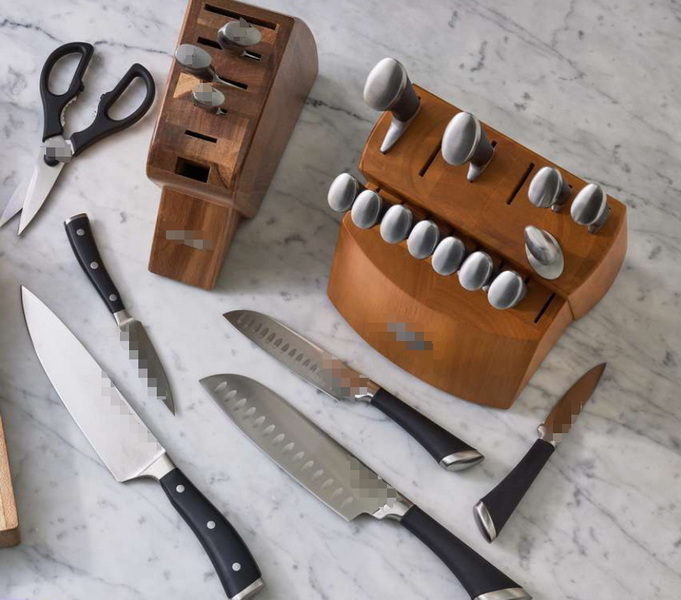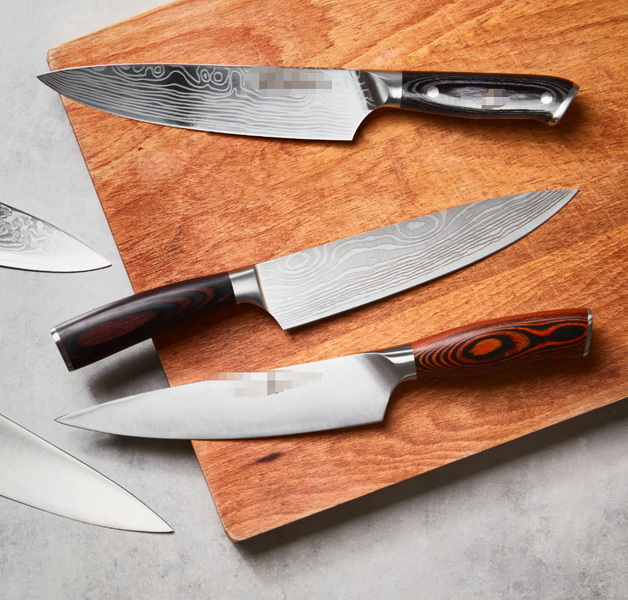- All
- Product Name
- Product Keyword
- Product Model
- Product Summary
- Product Description
- Multi Field Search
Views: 222 Author: Ann Publish Time: 2025-07-23 Origin: Site











Content Menu
● Why Choosing the Right Kitchen Knife Set Matters for Beginners
● Key Knives to Include in a Beginner's Kitchen Knife Set
>> 2. Paring Knife (3.5 to 4-inch)
>> 3. Bread Knife (Serrated, ~8-inch)
>> 4. Utility Knife (5 to 6-inch)
● Additional Useful Knives for Beginners
● Recommended Kitchen Knife Sets for Beginners
>> 1. Cuisinart C77WTR 15-Piece Knife Set
>> 2. Cangshan S1 3-Piece Knife Set
>> 3. Ginsu Gourmet Chikara 5-Piece Set
● Essential Kitchen Knife Skills for Beginners
>> Proper Grip
>> Knife Safety
● Factors to Consider When Buying a Kitchen Knife Set
>> 1. How many knives should a beginner start with?
>> 2. Are expensive kitchen knife sets necessary for beginners?
>> 3. How often should I sharpen my kitchen knives?
>> 4. Should beginners buy individual knives or sets?
>> 5. What is the safest way to handle kitchen knives?
When starting out in cooking, having the right kitchen knife set is essential for efficiency, safety, and enjoyment. The ideal kitchen knife set for beginners should balance quality, versatility, comfort, and value. It should include the most commonly used knives that cover a variety of kitchen tasks, with blades that feel comfortable and sharp out of the box. This guide will walk you through what to look for, recommend some excellent beginner sets, and provide crucial tips to help you become confident with your knives.

A quality kitchen knife set is more than just a tool—it's the foundation of your cooking experience. Good knives:
- Reduce the risk of injury: Sharp, well-balanced knives require less force, making cutting tasks safer.
- Improve cooking results: Clean cuts help preserve food texture and appearance.
- Save time and energy: Efficient knives speed up prep and reduce fatigue.
- Encourage skill growth: Comfortable, reliable knives boost confidence and help beginners try new techniques.
Many beginners mistakenly opt for large, flashy knife sets with many pieces, but this can be overwhelming and unnecessary. Instead, focus on starting small with essential knives that are versatile and easy to use.
Knowing the purpose of each knife helps you select and use them properly in the kitchen. The following knives are the foundation of any good beginner kitchen knife set:
The chef's knife is the most versatile knife in your kitchen—it's perfect for chopping vegetables, slicing meat, dicing herbs, and mincing garlic. The 8-inch size generally balances control and cutting surface, making it ideal for various tasks. When choosing a chef's knife, look for a full tang blade (where the metal runs through the handle) to ensure durability and balance.
Smaller and nimble, the paring knife is designed for tasks requiring precision: peeling, trimming, and detailed cutting work like deveining shrimp or hulling strawberries. It allows much better control than a larger knife.
The bread knife features a serrated edge to easily slice through crusty breads, tomatoes, and other delicate foods without crushing them. Its saw-like teeth grip the bread crust and cut cleanly inside.
A utility knife is a mid-sized all-rounder between the chef's and paring knives. It's perfect for cutting sandwiches, slicing small fruits, or performing smaller meaty cuts when a chef's knife is too bulky.
While 3-5 knives cover the essentials, some beginners may appreciate additional knives for special tasks:
- Santoku Knife: A Japanese-style all-purpose knife similar to a chef's knife but lighter with a flatter edge and hollow-grantles for less sticking.
- Boning Knife: Thin and flexible, designed for separating meat from bone.
- Steak Knives: Useful for those who eat meat regularly; sharper and easier to handle than regular table knives.、

Choosing a knife set that balances quality, price, and usability is crucial for beginners. The following are some excellent options that are well-reviewed for beginners worldwide:
- Features: Full tang forged stainless steel blades, triple-riveted ergonomic handles, included honing rod and kitchen shears.
- Pros: Sharp edge retention out of the box, extensive set covers varied needs, visually attractive hardwood block.
- Cons: Not dishwasher safe, smaller knives have thinner blades that feel less sturdy.
- Best for: Beginners wanting a large set for different kitchen needs and budget-conscious buyers.
- Features: German X50Cr15MoV steel blades, full tang, natural walnut handles, forged blade, lifetime warranty.
- Pros: Exceptional sharpness and edge holding, well-balanced, compact for small kitchens.
- Cons: Limited number of knives, no room for expansion in block.
- Best for: Beginner chefs seeking top quality and simplicity in a small set.
- Features: Forged carbon steel blades, lifetime warranty, compact bamboo block design.
- Pros: Great value, good sharpness retention, ideal for small kitchens or as travel knife sets.
- Cons: Softer steel requiring more frequent sharpening, lacks steak knives.
- Best for: Budget-conscious beginners or those needing smaller knives.
Owning the ideal kitchen knife set is only part of the equation—knowing how to handle them effectively and safely is equally important.
The pinch grip is widely recommended for both comfort and control. Place your thumb and forefinger on opposite sides of the blade near the handle, holding the rest of the fingers around the handle. This grip stabilizes the blade and reduces fatigue.
Practice foundational cuts such as:
- Slicing: Long smooth motions for vegetables and meat.
- Dicing: Cross-cutting uniformly for recipes.
- Chopping: Quick, repetitive motion for herbs or onions.
- Julienning: Fine stick cuts useful for garnishes and stir-fries.
- Cut away from your body.
- Always use a stable cutting board with grip or damp towel underneath.
- Keep fingers curled inward on the non-cutting hand (“claw grip”).
- Never leave knives loose in drawers—store safely in blocks or sheaths.
To keep your kitchen knives sharp and lasting long:
- Hone regularly: Use a honing rod every few uses to realign edges.
- Sharpen when dull: Use whetstones or professional sharpening once or twice yearly.
- Clean properly: Wash knives by hand and dry immediately to prevent rust.
- Avoid cutting hard surfaces: Use wooden or plastic cutting boards, not glass or stone.
When choosing the right beginner kitchen knife set, consider the table below:
| Factor | Details | Importance for Beginners |
|---|---|---|
| Blade Material | Stainless steel = rust-resistant and easy to maintain; high-carbon steel = sharper but needs care | Stainless steel recommended for easier upkeep |
| Knife Weight & Balance | Should feel balanced and comfortable in your hand | Ergonomics prevent hand fatigue and ensure control |
| Handle Material | Options include wood, plastic, composite, each with pros and cons | Comfortable, slip-resistant handles improve safety |
| Number of Pieces | Smaller 3-5 knife sets cover most needs; avoid oversized sets | Easier to learn with fewer knives |
| Sharpening & Care | Check if honing rod or sharpener included, and ease of maintenance | Regular care prolongs knife lifespan |
Choosing the ideal kitchen knife set for beginners is a balance between quality, price, comfort, and usability. Essential knives—like the chef's knife, paring knife, bread knife, and utility knife—provide a versatile foundation. Sets like Cuisinart C77WTR, Cangshan S1, and Ginsu Gourmet Chikara cater to different needs, budgets, and kitchen sizes.
Along with selecting the right knives, learning proper cutting techniques, gripping methods, safety precautions, and maintenance routines ensures you get the most from your kitchen knives. Ultimately, the right set makes cooking easier, safer, and more enjoyable for any beginner.

A starter set of 3 to 5 essential knives (chef's knife, paring knife, bread knife, utility knife) generally covers the majority of basic kitchen tasks without overwhelming a new cook.
Not necessarily. Many mid-range or budget-friendly sets provide sufficient quality and durability. Your choice should balance budget, comfort, and blade quality.
Honing should occur every few uses to keep edges aligned. Sharpening can be done 1–2 times a year or when you feel performance drops.
Sets provide immediate versatility and value, while individual knives allow targeted purchases. Beginners often benefit from sets to cover all essential tasks.
Use proper grips (pinch or claw), cut on stable surfaces, keep knives sharp, and store them securely out of reach of children.
The Ultimate Professional Knives for Halal Butchery in Middle Eastern Kitchens
Chef Knife Size Guide: Choosing Between 6″, 8″, 10″, And 12″
Custom Knife Handles: How To Design A Chef Knife That Fits Your Hand Perfectly
Chef Knife Surface Treatments Guide: From Polished Migaki To Damascus Patterns
Inside Our Professional Knife Sample Room: Quality You Can See
Universal Knife Block Buying Guide: Modern Acrylic & ABS Knife Holders for Professional Kitchens
Universal Knife Block: The Complete Guide To Modern, Hygienic Knife Storage
The Complete Guide To Red Handle Knife Sets: Style Meets Functionality in The Kitchen
Professional Knives for Halal Butchery And Middle Eastern Cuisine